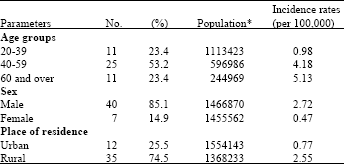Research Article
Incidence of Leptospirosis in Mazandaran Province, North of Iran: A One Year Survey
Faculty of Nursing, Mazandaran University of Medical Sciences, Sari, Iran
A. Hesamzadeh
Community Health Nursing, Mazandaran University of Medical Sciences, Sari, Iran
R. Alizadeh-Navaei
Mazandaran University of Medical Sciences, Sari, Iran
M. H. Haghshenas
Department of Microbiology, Mazandaran University of Medical Sciences, Sari, Iran
F. Alhani
University of Tarbiat Modares, Tehran, Iran









